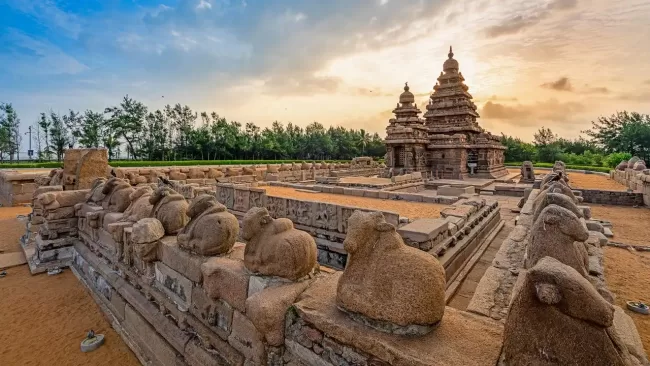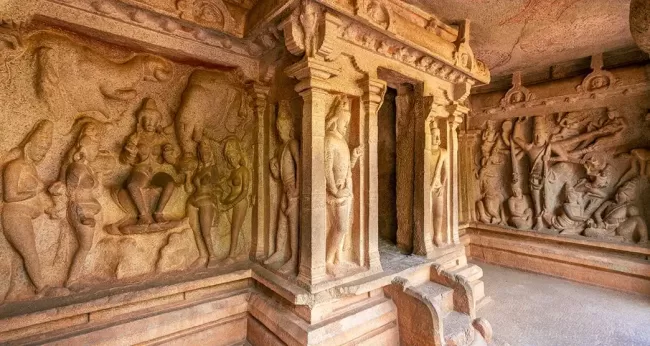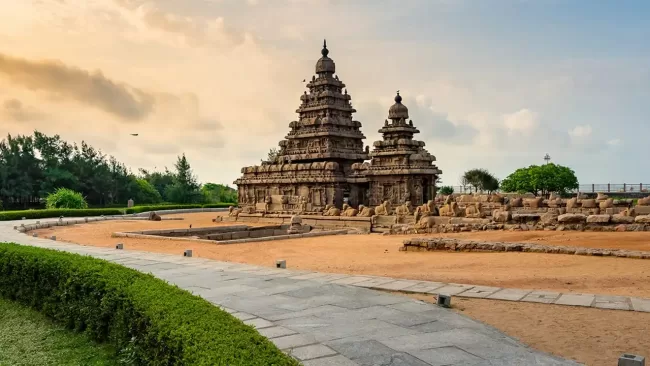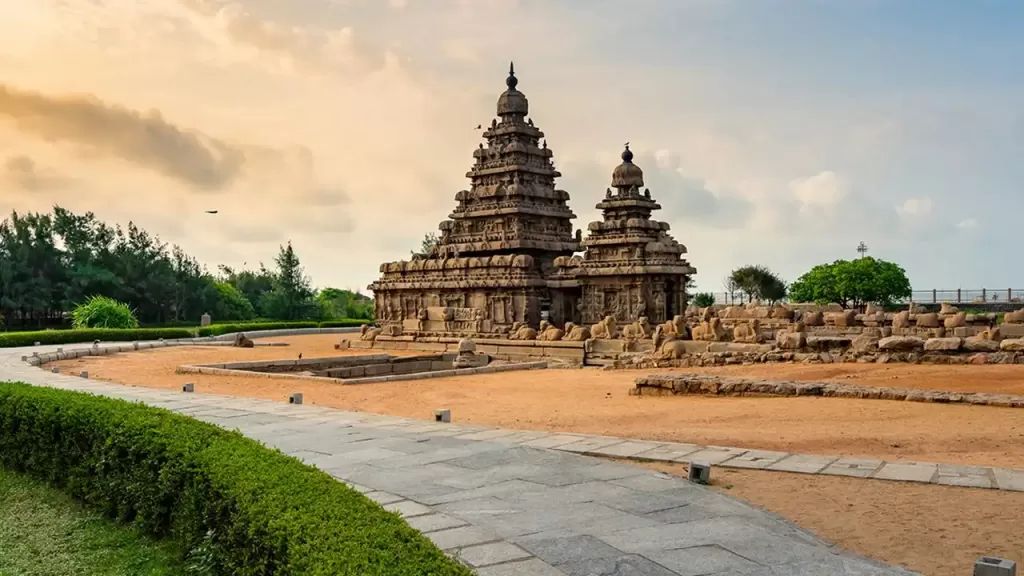Shore Temple: The Pride of Mahabalipuram’s UNESCO Heritage Nestled along the Coromandel Coast, where the Bay of Bengal whispers secrets to the sun-kissed shores, stands the magnificent Shore Temple of Mamallapuram. Also known as Mahabalipuram, this historic site, located south of Chennai in Tamil Nadu, is a UNESCO World Heritage Site and an enduring symbol of the Pallava dynasty’s architectural brilliance.
ALSO READ: Bangaram Island: Your Gateway to Paradise in Lakshadweep
Unlike the more common rock-cut temples of its time, the Shore Temple is a structural masterpiece, carved from granite over 1,300 years ago. Its striking pyramidal towers rise like sharpened prayers, standing as a testament to the Tamil people’s craftsmanship and artistic excellence.

Shore Temple Architectural Brilliance and Spiritual Significance
The Shore Temple is unique in its tripartite structure, housing three shrines dedicated to Lord Shiva and Lord Vishnu. As one of the earliest structural temples in South India, it differs from monolithic cave temples, showcasing a transition in Pallava architecture.
Key Features:
- Pyramidal Towers – Intricately carved and rising in a tiered fashion, they define the temple’s silhouette.
- Granite Superstructure – Built to withstand the relentless waves of the Bay of Bengal.
- Dual Purpose – Served as both a sacred place of worship and a landmark for seafarers navigating the maritime trade routes.
A Journey Through Time: History and Legends in Shore Temple
Origins and Construction
- Built in the early 8th century during the reign of Pallava king Narasimhavarman II (Rajasimha).
- Once part of a grand complex of seven temples, known in legend as the Seven Pagodas.
- Over time, the Bay of Bengal claimed six of these structures, leaving the Shore Temple as the sole survivor.
The Mystery of the Lost Pagodas
- The legend of the submerged temples has intrigued travelers for centuries.
- Venetian explorer Marco Polo (13th century) referred to the site as the Seven Pagodas, adding to its Western mystique.
- The 2004 tsunami briefly revealed submerged ruins, supporting historical accounts and sparking new archaeological interest.
Enduring Legacy
Despite centuries of natural challenges, the Shore Temple remains a symbol of resilience, history, and spirituality. Today, it continues to inspire visitors, archaeologists, and historians, preserving the artistic and cultural legacy of the Pallavas.
Why It Matters:
UNESCO World Heritage Site of global significance.
A fusion of art, devotion, and maritime history.
A living testament to South India’s architectural evolution.
The Shore Temple, standing firm against the tides of time, remains a beacon of the past, whispering stories of devotion, artistry, and lost wonders beneath the sea.

Divine Echoes: Unveiling the Significance of the Shore Temple
The Shore Temple is more than a marvel of stone architecture; it is a sacred space where the celestial meets the earthly. Dedicated to both Lord Shiva and Lord Vishnu, this temple complex embodies Hindu theological principles, reflecting the harmonious integration of Shaivism and Vaishnavism—a hallmark of the Pallava dynasty’s religious inclusivity.
A Sacred Connection to the Elements
Referred to as Jalashayana, meaning ‘lying in water’, the temple’s placement by the sea enhances its spiritual and elemental significance. The structure is deeply intertwined with nature, symbolizing the divine presence within the forces of creation and preservation.
Inscriptions and Historical Identifications
Ancient inscriptions found within the smaller Shiva shrine in the temple complex provide insights into its historical names:
- Kshatriyasimha Pallavesvara-gruham
- Rajasimha Pallavesvara-gruham
- Pllikondaruliya-devar
Additionally, the shrine dedicated to Vishnu—the first to be carved—is named Narapatisimha Pallava Vishnu Griha in the inscriptions. This underscores King Rajasimha’s devotion and influence in shaping the temple’s construction.
The Shore Temple stands as an eternal testament to the spiritual and artistic vision of the Pallavas, preserving their devotion and legacy for generations to come.
A Fusion of Styles: Unveiling the Architectural Brilliance of the Shore Temple
The Shore Temple, perched on a single platform, is a striking blend of architectural styles. Unlike the predominantly rock-cut monuments of Mamallapuram, this temple is one of the earliest significant structural temples in South India. Built from locally sourced granite, it rises 60 feet high on a 50-foot square base, with its main shrine oriented eastward to capture the first rays of the sun upon the Shiva Linga.
Structural Composition
- The complex houses three shrines:
- The main shrine dedicated to Lord Shiva (facing east).
- A second shrine devoted to Shiva, positioned orthogonally.
- A smaller central shrine, which enshrines a reclining Vishnu, possibly designed to facilitate water flow into the sanctum.
- The pyramidal dual shikharas (towers) feature distinct overhanging eaves, while a transverse barrel-vaulted gopuram marks the entrance.
- Sculptural elements include imposing Nandi figures and rearing lions adorning the outer walls, enhancing the temple’s grandeur.
Architectural Influences and Features
- The temple exhibits Dravidian octagonal shikharas, crowned with ornate finials, reminiscent of the Pancha Rathas.
- The temple’s columns rest on lion bases, adding to its aesthetic and structural integrity.
- Being located near the sea, the temple has endured erosion, affecting some of its external decorations.
Exploring the Inner Sanctums of the Shore Temple
Within the garbhagriha (sanctum sanctorum) lies a Sivalinga, accompanied by a small mandapa. Encased within a strong outer wall, the limited space allows for circumambulatory movement around the shrine.

Key Inner Features:
- Two rear-facing shrines:
- One, dedicated to Ksatriyasimnesvara, is accessible via a passage.
- The other, facing outward, is devoted to Lord Vishnu.
- The Dharalinga in the east-facing Kshatriyasimhesvara temple is a sixteen-faced black basalt Shivalinga, measuring 6 feet high. Though the upper portion is damaged, the fluted crown remains visible.
- A Somaskanda panel, depicting Shiva, Parvati, and Kartikeya, reflects artistic themes found in the Dharmaraja Ratha, dating back to Paramesvarvarman’s era.
Additional Sculptural Highlights:
- Brahma and Vishnu sculptures adorn the ardhamandapa (anteroom) leading to the sanctum.
- Depictions of Shiva as Tripurantaka and Durga are carved onto the north wall.
- A circumambulatory passage allows for ritualistic clockwise movement around the shrine.
A Testament to the Pallavas’ Artistic Mastery
The Shore Temple seamlessly blends structural ingenuity with sacred symbolism, standing as a testament to the Pallava dynasty’s architectural legacy. Despite centuries of erosion, it remains an awe-inspiring relic of South Indian temple craftsmanship, preserving the essence of devotion, art, and history.
Architectural Splendor of the Smaller Shrines in the Shore Temple Complex
The Distinctive Double-Storey Shiva Temple
Located behind the main temple, the smaller Shiva shrine stands out with its two-tiered stepped pyramidal tower, crowned by an octagonal shikhara resting on a circular griva, and adorned with a kalasa and finial.
Key Architectural Features:
- Kudus (horseshoe-arch dormer projections) embellish the structure.
- Small shrines are positioned on the cornices of both levels.
- The back wall of the inner shrine features a Somaskanda panel.
- The absence of a mandapa suggests prior damage.
- Significant exterior carvings include:
- Ekapadamurti – Shiva standing on one leg, flanked by Brahma and Vishnu.
- Nagaraja – Depiction of a divine serpent beneath a five-hooded cobra.
The Anantashayi Vishnu Shrine
Between the Kshatriyasimhesvara temple and the Rajasimha Pallavesvara temple lies a small shrine dedicated to Vishnu in his reclining form (Anantashayi Vishnu).
Structural Elements:
- Vishnu rests on Ananta, but the sculpture has suffered damage, with missing attributes.
- The shrine’s rectangular tower is no longer intact, but remnants of its cornice, kudus, and Krishna-related carvings remain.
The Protective Perimeter of the Temple Complex
The surrounding wall of the temple complex is richly adorned with:
- Large sculptures of Nandi – symbolic of Shiva’s mount.
- Yalis – mythical lion-like creatures.
- Varahas – representations of Vishnu’s boar incarnation.
- A Pallava Grantha script inscription on the lintel identifies this as the earliest shrine in the complex.
The presence of both Shaivite and Vaishnavite deities within the temple further emphasizes the syncretic religious landscape of the Pallava era, including a Durga figure seated on a lion.

The Shore Temple’s Enduring Legacy of Structural Innovation
As one of the first significant stone-built temples in South India, the Shore Temple marked a transition from earlier wood and metal-based temple construction to entirely stone-based structures.
Key Innovations:
- First-of-its-kind stone construction, setting a precedent for later Dravidian temples.
- Dry masonry technique – interlocking stones without mortar, ensuring stability for over a millennium.
- Resilient design – despite exposure to harsh coastal conditions, the temple remains largely intact.
This pioneering approach not only contributed to the longevity of the Shore Temple but also influenced the architectural evolution of South India’s temple-building traditions.
Unraveling the Symbolism and Celestial Alignments of the Shore Temple
The Shore Temple is not only a marvel of architecture and craftsmanship but also a structure deeply rooted in celestial symbolism. Its east-facing orientation ensures that the first light of the rising sun directly illuminates the Shiva Linga in the main shrine, symbolizing divine blessings and spiritual renewal.
Additionally, the temple’s layout and deity placements are believed to align with astronomical markers, enhancing its significance during religious festivals and celestial events. Such alignments reflect the advanced astronomical knowledge of the Pallavas, who integrated cosmic principles into temple design.
Festivals of Devotion: Celebrating Faith at the Shore Temple
The Shore Temple comes alive with grandeur during significant festivals:
- Mahashivratri – Devotees gather in large numbers to offer prayers, perform rituals, and celebrate the cosmic dance of Shiva.
- Brahmotsavam – A festival filled with religious ceremonies, processions, and reenactments of mythological tales connected to Shiva and Vishnu.
- Mamallapuram Dance Festival – An annual cultural spectacle set against the temple’s stunning backdrop, where classical dance performances pay tribute to the Pallava legacy of artistic patronage.
These celebrations transform the Shore Temple into a living entity, where the echoes of ancient traditions, devotion, and artistic expression continue to thrive.
A Journey Through Time: Finding Inspiration in the Shore Temple
The Shore Temple is more than a historical monument—it is a portal to the past, standing resilient against the test of time. As you walk through its weathered stone corridors, envision the once-thriving port city of Mamallapuram, bustling with merchants, artisans, and seafarers. Feel the ocean breeze, carrying whispers of forgotten stories from ancient mariners, and hear the echoes of devotional chants resonating through its sacred walls.
This temple stands as a testament to human ingenuity, devotion, and artistic brilliance. Let its intricate carvings awaken your curiosity, its serene presence calm your spirit, and its enduring legacy inspire your journey of exploration and faith.


